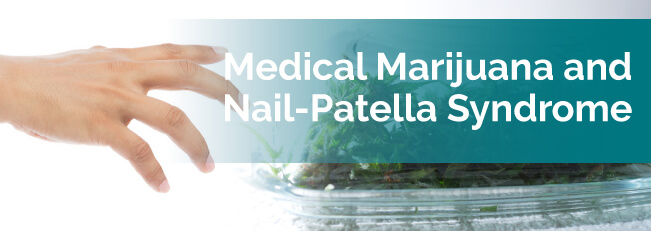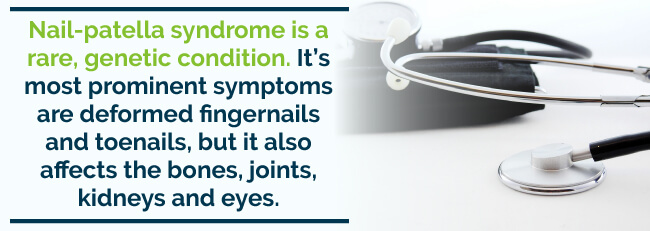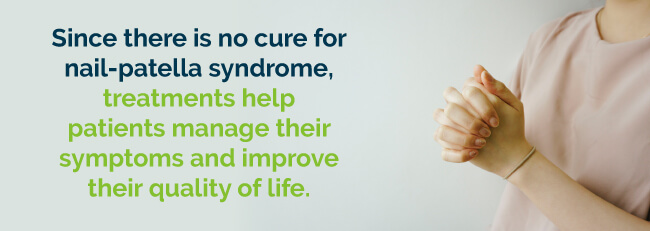
Nail-patella syndrome (NPS) isn’t a qualifying condition in most of the states where medical marijuana is legal. However, states like Michigan, Illinois and Maine recognize that the symptoms and complications of this rare disorder make those who suffer from it suitable candidates for medical cannabis treatments.
And while there’s no cure for this disorder, medical weed can provide relief. So, if you’re struggling with nail-patella syndrome, read more to find out how medical marijuana could help manage your symptoms.
Nail-patella syndrome is a rare, genetic condition. It’s most prominent symptoms are deformed fingernails and toenails, but it also affects the bones, joints, kidneys and eyes. The disorder can result in noticeable skeletal deformities as well.

Other names for this disorder are:
Some of the first signs of NPS appear in infancy or early childhood. Parents may notice when their child is born, for example, that their fingernails haven’t developed properly. Doctors can make an early diagnosis through a physical examination, x-rays or genetic testing.
Nail-patella syndrome is an inherited genetic condition. Approximately one out of every 50,000 babies bornwill have this disorder. The mutation that causes NPS occurs in a gene called the LIM Homeobox Transcription Factor 1-Beta (LMX1B) located on chromosome nine. This gene codes limb development in embryos.
The mutation is an autosomal dominant trait, meaning only one parent needs to be affected for the mutation to appear in their child. Individuals with a family history of the condition are more likely to develop the severe symptoms associated with it. Rare cases of NPS have developed without the patient having a family history of the condition.
The symptoms associated with nail-patella syndrome develop because of connective disuse and collagen abnormalities. These changes lead to the visual symptoms, like discolored or missing nails, often associated with the condition.
Signs of NPS vary. Parents could have no apparent symptoms of the disease, for example, while their children have a more severe case. Similar symptoms, like nail abnormalities, occur in most patients. The symptoms themselves, however, range from mild to severe.
One sign that appears in almost every NPS patient is nail abnormalities. Your thumbs’ nails are usually affected the most. Toenail irregularities are rarer than changes in your fingernails. The most common nail features of nail-patella syndrome include:
Although nail irregularities are an annoyance to nail-patella syndrome sufferers, more serious symptoms can also develop. Most of these involve skeletal abnormalities affecting the knees, hips and elbows.
Some of these skeletal symptoms include:
The kidneys and eyes can also be affected by NPS. Because of filtration issues, kidney problems develop in thirty to forty percent of reported cases. In extreme instances, kidney problems can lead to high blood pressure and renal failure.
Glaucoma is another major side effect of this disorder and can develop early. Glaucoma develops when there is increased fluid pressure in your eyes because the outflow is blocked. Other eye abnormalities related to nail-patella syndrome include your irises, or the colored portion of your eyes, becoming dark or clover-shaped.
Other rare symptoms associated with NPS include:
Because these symptoms develop or become visible during early childhood, patients can start treatment early. Knowing if your family has a history of NPS also makes you more aware of its signs and to look for them in your children.
Since there is no cure for nail-patella syndrome, treatments help patients manage their symptoms and improve their quality of life. NPS patients should seek medical attention at an early age, and if your family has a history of the condition, consider having your child tested to be safe.

Treatments recommended by physicians vary from case to case. Each patient presents different symptoms, which range in severity. Thus, not all treatments are necessary or helpful. Patients with nail-patella syndrome should undergo regular screenings for orthopedic issues, kidney problems and glaucoma.
Therapies for NPS are broken into three areas — orthopedic, kidney and glaucoma. Some of the most common treatments for these issues include:
Because of the nature of this disorder, dislocations and other knee and hip problems are not uncommon. When you dislocate your knee or hip, it can be excruciating. Some of the orthopedic problems caused by nail-patella syndrome become so severe that surgery is required.
Treatments for orthopedic symptoms include:
Orthopedic treatments often rely on a combination of the above therapies. Many patients, for example, may use pain medicine and physical therapy to combat their daily discomfort.
All nail-patella syndrome patients should get regular screenings for renal disease. If caught early, you can begin treatment and restore function to your kidney. Kidney disease treatments are the same whether the disease results from NPS or another issue:
Scheduling appointments to check for kidney disease are essential to managing NPS and ensuring you receive prompt treatment should the condition begin to affect your kidneys.
If not treated, glaucoma can lead to narrowed visual perception and blindness. If you lose your vision, it’s irreversible. Regular appointments with an optometrist can catch this symptom early.
A few options are available for reducing eye pressure and opening blockages to improve fluid drainage. The most common treatments are:
In some cases, surgery or laser treatments are unavoidable if you want to preserve your vision. If you do proceed with these more aggressive treatments, it’s crucial you select an experienced doctor to perform the procedure.
While these traditional treatments are all that is available to some patients across the U.S., those in states where medical marijuana is legal can use it to alleviate their day-to-day symptoms.
Medical marijuana for nail-patella syndrome is an excellent treatment option for individuals who greatly suffer from the disorder. The best thing about medical cannabis for nail-patella syndrome is it can help with several of the associated complications, such as pain, glaucoma and kidney disease.
Pain management is a major concern for NPS patients. Prescription opioids pose a significant risk to those with nail-patella syndrome. Long-term use of painkillers can damage kidneys and cause renal failure — patients with NPS are already at risk of kidney failure, making for a high-risk combination.

When medical marijuana is used to treat nail-patella syndrome, patients experience reduced bouts of pain with none of the dangerous side effects of prescription opioids. They also report feeling more active, letting them live their lives to its fullest extent. For patients, that makes medical marijuana an effective, low-risk treatment.
Many of the ailments caused by nail-patella syndrome are treatable with medical marijuana. It’s a safe alternative to prescription drug use, and NPS patients across the U.S. are finding relief with it.
Medical cannabis treats the following symptoms of nail-patella syndrome:
Joint abnormalities can cause severe pain. Medical marijuana is well-documented as an effective pain reliever. It targets pain located in the bones, ligaments and tendons. Cannabis even treats aches from scoliosis, another potential symptom of NPS.
Nail-patella syndrome also makes joints swollen or inflamed. The cannabinoids, tetrahydrocannabinol (THC)and beta-caryophyllene (E-BCP) are compounds in cannabis with anti-inflammatory properties.
If you wish to avoid the psychoactive high often associated with medical weed, a strain with low THC and high cannabidiol (CBD) amounts can give you a break from chronic discomfort while still maintaining a clear mind.
Medical marijuana is shown to lower the risk of kidney disease. It helps kidney health with the same anti-inflammatory properties mentioned above. These properties fight off disease and promote tissue repair. CBD also acts as a detoxifier for the body by reducing oxidative stress. This type of stress is known to increase the likelihood of pathophysiological conditions, like kidney disease.
For NPS patients with renal failure, medical marijuana can also help. It works by reducing spasms, as well as increasing your appetite, as kidney disease can lead to weight loss and a lack of hunger.
Medical cannabis significantly slows the progression of glaucoma by relieving ocular pressure. Marijuana’s neuroprotection and vasodilation properties, which decrease blood pressure, also assist in the treatment of glaucoma.

In one study, researchers found that medical marijuana reduced eye pressure for eight to 12 hours when the cannabis was administered as a topical. Another study, which tested animals, found the effects lasted for around six hours.
As medical marijuana becomes legalized in more states, additional studies can give us more insight into its benefits for different diseases and conditions, including nail-patella syndrome. Patients agree though — the natural treatment helps them.
The number of medical marijuana strains available is incredible. No longer do patients choose between one or two options. They can now select designer strains, tailor-made to treat a plethora of symptoms. If you need help finding the perfect strain for you, a medical marijuana doctor or local budtenders at your dispensary will have recommendations.
Here is a short list of recommendations for managing symptoms from nail-patella syndrome:
If your main discomfort from NPS is chronic pain, you have a wide selection of strains available. Two of the most helpful ones include:
Dispensaries in your area may have these two strains available or similar ones that you can try.
You can also alleviate chronic pain from NPS by using anti-inflammatory strains, like:
If your local dispensary doesn’t offer these strains, they’ll be able to recommend an alternative with similar effects and CBD and THC content.
People have treated glaucoma with medical marijuana since at least the 1970s. Helpful strains for glaucoma include:
While your dispensary may not have these strains in stock, they likely have comparable strains available.
One of the reasons why dispensary selections vary is because medical marijuana isn’t something growers can import or export. As medical marijuana becomes more accepted as a part of the medical field, laws could change and allow growers to ship medical weed to different states.
The most common way of taking medical cannabis for nail-patella syndrome is by smoking or vaporization. While these methods provide quick relief, you may want to try some alternative modes:
State laws determine what administration modes are legal. Some don’t allow the smoking of medical marijuana, though most approve topicals and tinctures. Your medical cannabis doctor can talk to you about your state’s laws.
Many states approve medical marijuana for patients with debilitating conditions. If you would like to apply for one of these programs, you must prove that you have a qualifying condition. Even though NPS isn’t eligible in every state, it’s symptoms, like glaucoma and chronic pain could qualify you.
If you’re ready to take the next step in treating your nail-patella syndrome with medical marijuana, you need to make an appointment with a local marijuana doctor. These medical professionals are qualified to diagnose and recommend this all-natural treatment option. Meet with one of these compassionate physicians by searching for a medical cannabis doctor near you.
Find A Doctor Find A Dispensary